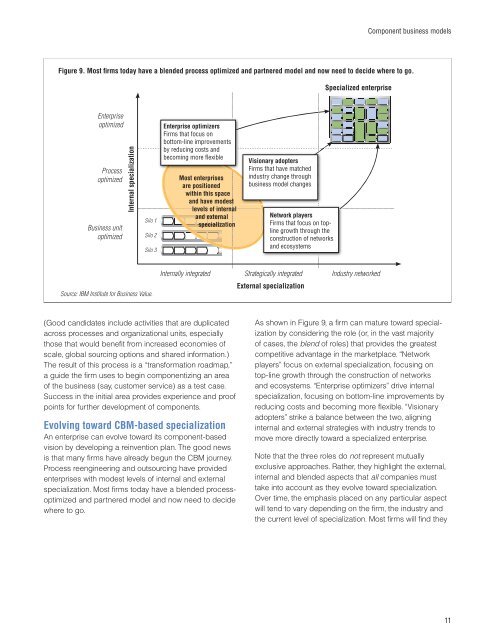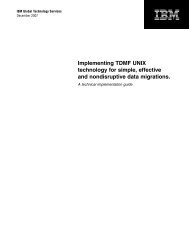Component business models - IBM
Component business models - IBM
Component business models - IBM
You also want an ePaper? Increase the reach of your titles
YUMPU automatically turns print PDFs into web optimized ePapers that Google loves.
(Good candidates include activities that are duplicated<br />
across processes and organizational units, especially<br />
those that would benefit from increased economies of<br />
scale, global sourcing options and shared information.)<br />
The result of this process is a “transformation roadmap,”<br />
a guide the firm uses to begin componentizing an area<br />
of the <strong>business</strong> (say, customer service) as a test case.<br />
Success in the initial area provides experience and proof<br />
points for further development of components.<br />
Evolving toward CBM-based specialization<br />
An enterprise can evolve toward its component-based<br />
vision by developing a reinvention plan. The good news<br />
is that many firms have already begun the CBM journey.<br />
Process reengineering and outsourcing have provided<br />
enterprises with modest levels of internal and external<br />
specialization. Most firms today have a blended processoptimized<br />
and partnered model and now need to decide<br />
where to go.<br />
<strong>Component</strong> <strong>business</strong> <strong>models</strong><br />
Figure 9. Most fi rms today have a blended process optimized and partnered model and now need to decide where to go.<br />
Enterprise<br />
optimized<br />
Process<br />
optimized<br />
Business unit<br />
optimized<br />
Internal specialization<br />
Silo 1<br />
Silo 2<br />
Silo 3<br />
Source: <strong>IBM</strong> Institute for Business Value.<br />
Enterprise optimizers<br />
Firms that focus on<br />
bottom-line improvements<br />
by reducing costs and<br />
becoming more fl exible<br />
Most enterprises<br />
are positioned<br />
within this space<br />
and have modest<br />
levels of internal<br />
and external<br />
specialization<br />
Visionary adopters<br />
Firms that have matched<br />
industry change through<br />
<strong>business</strong> model changes<br />
Network players<br />
Firms that focus on topline<br />
growth through the<br />
construction of networks<br />
and ecosystems<br />
Specialized enterprise<br />
Internally integrated Strategically integrated<br />
External specialization<br />
Industry networked<br />
As shown in Figure 9, a firm can mature toward specialization<br />
by considering the role (or, in the vast majority<br />
of cases, the blend of roles) that provides the greatest<br />
competitive advantage in the marketplace. “Network<br />
players” focus on external specialization, focusing on<br />
top-line growth through the construction of networks<br />
and ecosystems. “Enterprise optimizers” drive internal<br />
specialization, focusing on bottom-line improvements by<br />
reducing costs and becoming more flexible. “Visionary<br />
adopters” strike a balance between the two, aligning<br />
internal and external strategies with industry trends to<br />
move more directly toward a specialized enterprise.<br />
Note that the three roles do not represent mutually<br />
exclusive approaches. Rather, they highlight the external,<br />
internal and blended aspects that all companies must<br />
take into account as they evolve toward specialization.<br />
Over time, the emphasis placed on any particular aspect<br />
will tend to vary depending on the firm, the industry and<br />
the current level of specialization. Most firms will find they<br />
11

















